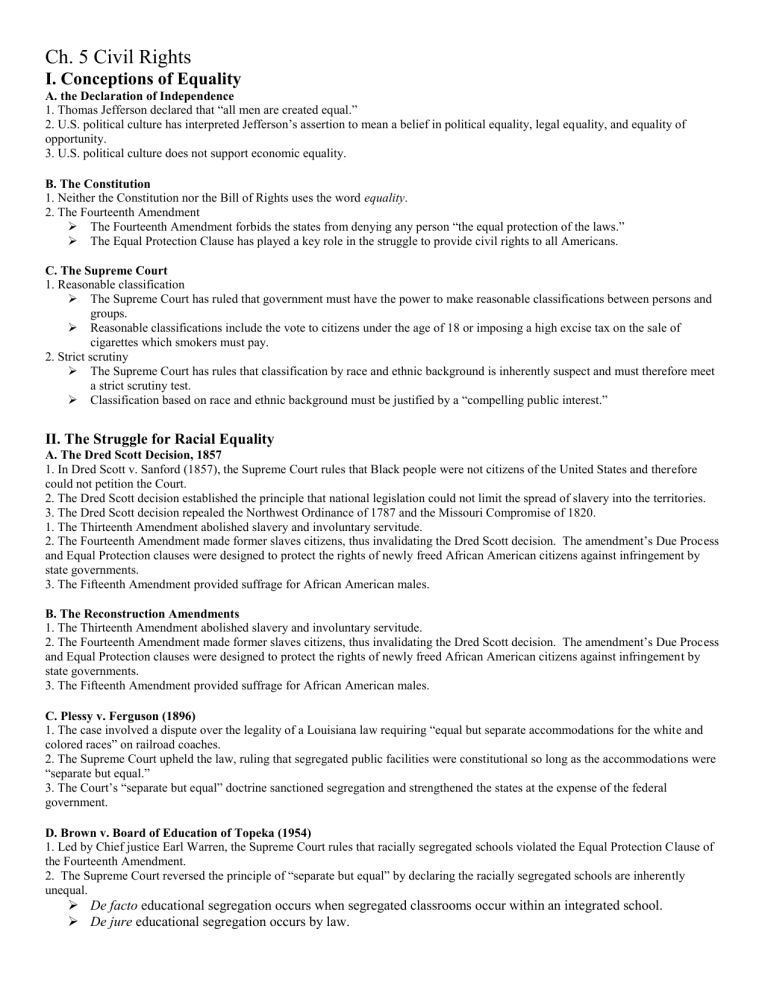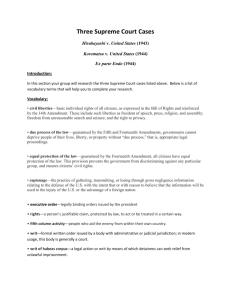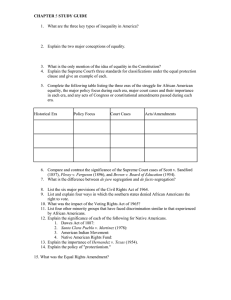Ch. 5 Civil Rights I. Conceptions of Equality

Ch. 5 Civil Rights
I. Conceptions of Equality
A. the Declaration of Independence
1. Thomas Jefferson declared that “all men are created equal.”
2. U.S. political culture has interpreted Jefferson’s assertion to mean a belief in political equality, legal equality, and equality of opportunity.
3. U.S. political culture does not support economic equality.
B. The Constitution
1. Neither the Constitution nor the Bill of Rights uses the word equality .
2. The Fourteenth Amendment
The Fourteenth Amendment forbids the states from denying any person “the equal protection of the laws.”
The Equal Protection Clause has played a key role in the struggle to provide civil rights to all Americans.
C. The Supreme Court
1. Reasonable classification
The Supreme Court has ruled that government must have the power to make reasonable classifications between persons and groups.
Reasonable classifications include the vote to citizens under the age of 18 or imposing a high excise tax on the sale of cigarettes which smokers must pay.
2. Strict scrutiny
The Supreme Court has rules that classification by race and ethnic background is inherently suspect and must therefore meet a strict scrutiny test.
Classification based on race and ethnic background must be justified by a “compelling public interest.”
II. The Struggle for Racial Equality
A. The Dred Scott Decision, 1857
1. In Dred Scott v. Sanford (1857), the Supreme Court rules that Black people were not citizens of the United States and therefore could not petition the Court.
2. The Dred Scott decision established the principle that national legislation could not limit the spread of slavery into the territories.
3. The Dred Scott decision repealed the Northwest Ordinance of 1787 and the Missouri Compromise of 1820.
1. The Thirteenth Amendment abolished slavery and involuntary servitude.
2. The Fourteenth Amendment made former slaves citizens, thus invalidating the Dred Scott decision. The amendment’s Due Process and Equal Protection clauses were designed to protect the rights of newly freed African American citizens against infringement by state governments.
3. The Fifteenth Amendment provided suffrage for African American males.
B. The Reconstruction Amendments
1. The Thirteenth Amendment abolished slavery and involuntary servitude.
2. The Fourteenth Amendment made former slaves citizens, thus invalidating the Dred Scott decision. The amendment’s Due Process and Equal Protection clauses were designed to protect the rights of newly freed African American citizens against infringement by state governments.
3. The Fifteenth Amendment provided suffrage for African American males.
C. Plessy v. Ferguson (1896)
1. The case involved a dispute over the legality of a Louisiana law requiring “equal but separate accommodations for the white and colored races” on railroad coaches.
2. The Supreme Court upheld the law, ruling that segregated public facilities were constitutional so long as the accommodations were
“separate but equal.”
3. The Court’s “separate but equal” doctrine sanctioned segregation and strengthened the states at the expense of the federal government.
D. Brown v. Board of Education of Topeka (1954)
1. Led by Chief justice Earl Warren, the Supreme Court rules that racially segregated schools violated the Equal Protection Clause of the Fourteenth Amendment.
2. The Supreme Court reversed the principle of “separate but equal” by declaring the racially segregated schools are inherently unequal.
De facto educational segregation occurs when segregated classrooms occur within an integrated school.
De jure educational segregation occurs by law.
E. the Civil Rights Act of 1964
1. The bill finally passed when the Senate invoked cloture to end a filibuster that lasted 83 days.
2. The act did the following:
Ended Jim Crow segregation by making racial discrimination illegal in hotels, motels, restaurants, and other places of public accommodation.
Prohibited discrimination in employment on the basis of race, color, national origin, religion, or gender.
Created the Equal Employment Opportunity Commission to monitor and enforce protections against job discrimination.
Authorized the Departments of Justice to initiate lawsuits to desegregate public facilities and schools.
Prohibited discrimination in employment on grounds of race, color, national origin, or sex.
3. The Supreme Court upheld the provisions outlawing segregation in places of public accommodation by ruling that such segregation involved interstate commerce and thus fell under the legislative authority of Congress.
III. The Struggle for African American Voting Rights
A. Methods of Disenfranchising African American Voters
1. Poll taxes required voters to pay a special tax in order to vote.
2. Literacy or “understanding” tests required voters to pass difficult reading comprehension questions before they could register to vote.
3. White primaries excluded African Americans from voting in primary elections.
4. By 1960, only 29 percent of African Americans of voting age were registered to vote in the south. In contrast, 61 percent of whites were registered.
B.Eliminating The Poll Tax
1. The twenty-fourth amendment (1964) prohibited poll taxes in federal elections.
2. In 1966, the Supreme Court voided poll taxes in state elections.
C. The Voting Right Act of 1965
1. Outlawed literacy tests and other discriminatory practices had been responsible for disenfranchising African American voters.
2. Provided for federal oversight of voter registration in areas with a history of discriminating voting practices.
3. Significantly improved the voter registration disparity between white and African Americans. As the number of African American voters increased, so did the number of African American elected officials. In 1965, only about 70 African Americans held public office in the 11 southern states. By the early twenty-first century the number soared to over 5000.
D. Racial Gerrymandering
1. Following the 1990 census, several state legislatures created oddly shaped districts designed to give minority group voters a numerical majority.
2. In Shaw v. Reno (1993), the Supreme Court ruled that oddly shaped minority-majority districts would be held to a standard of strict scrutiny under the Equal Protection Clause.
3. Subsequent Supreme Court decisions refined the Shaw ruling by holding that the use of race as a “predominant factor” in drawing district lines should be presumed to be unconstitutional.
IV. Women’s Struggle for Civil Rights
A. Original Status of Women
1. Although women were considered citizens, they had no political rights.
2. Women were subjected to a male-dominated system of family law. For example, women could not divorce their husbands, sign contracts, or dispose of property.
3. Women were denied educational and career opportunities. For example, in 1873, the Supreme Court denied the right of women to practice law, saying, “The paramount destiny and mission of women are to fulfill the noble and benign offices of wife and mother.
This is the law of the creator.”
B. The Seneca Falls Convention, 1848
1. Elizabeth Cady Stanton and Lucretia Mott organized and led the Seneca Falls Convention.
2. The convention adopted resolution calling for the abolition of legal, economic, and social discrimination against women.
C. The Fight for Suffrage
1. Women’s rights activists were bitterly disappointed when the Fifteenth Amendment failed to grant women the right to vote.
2. The Nineteenth Amendment (1920) guaranteed women the right to vote.
D. The Equal Rights Amendment
1. Congress passed the Equal Rights Amendment (ERA) in 1972. The amendment provided that “equality of rights under the law shall not be denied or abridged by the U.S. or by any on account of sex.”
2. The ERA fell three states short of the three-fourths necessary for ratification.
E. Milestones in the Modern Women’s Rights Movement
1. The Equal Pay Act of 1963requires employers to pay women and men equal pay for equal work. Nonetheless, women still earn only
$0.81 for every $1.00 men make.
2. The Civil Rights Act of 1964 prohibited discrimination in employment based on race and sex.
3. In 1966, Betty Friedan and other leading feminists founded the National Organization of Women to challenge sex discrimination in the workplace.
4. Reed v. Reed (1971)
The Supreme Court ruled that and Idaho law that automatically preferred a father over a mother as executor of a son’s estate violated the Equal Protection Clause of the Fourteenth Amendment.
The Reed decision created a new standard for judging constitutionality in sex discrimination cases. The Supreme Court ruled that any law that classifies people on the basis of gender “must be reasonable, not arbitrary, and must rest on some ground of difference.” That difference must serve “important government objectives” and must be substantially related to those objectives.
5. Title IX of the Education Act of 1972 forbids educational institutions receiving federal funds from discriminating against female students. This provision has played a pivotal role in the development of women’s athletic programs.
F. Other Minority Groups
1. Native Americans
1. The oldest minority group in America, but they were not made U.S. citizens until 1924.
2. Hispanic Americans
1. Have displaced African Americans as the largest minority group, comprising about 14 percent of the U.S. population.
3. Asian Americans:
1. The fastest growing minority group, they now comprise four percent of the U.S. population.
2. During World War II, the U.S. government rounded up more than 100,000 Americans of Japanese descent and placed them in internment encampments known as “war relocation centers.”
3. The Supreme Court upheld the internment as constitutional in Korematsu v. United States (1944), but Congress later provided benefits for the former internees (which still have not been distributed).
G. Other Groups
1. There are more than 1.2 million persons of Arab ancestry in the United States.
V. Affirmative Action
A. Background
1. 1965, President Johnson issued an executive order requiring all contractors and unions doing business with the federal government to take affirmative action in hiring minorities. Two years later, this order was amended to extend affirmative action to women.
2. Affirmative action is a policy requiring federal agencies, universities, and most employers to take positive steps to remedy the effects of past discrimination.
B. The debate over affirmative action
1.Supporters
Supporters believe that affirmative action is needed to make up for past injustices. “Freedom is not enough,” insisted
President Johnson. “You do not take a person who for years has been hobbled by chains and liberate him, bring him to the starting line of a race and then say ‘you are free to compete with all the others’ and still justly believe that you have been completely fair.”
Supporters also argue that increasing the number of women and minorities in desirable jobs is an important social goal
2. Critics
Critics argue that affirmative actions programs create revere discrimination that unfairly penalizes members of the majority group.
Critics also contend that laws and policies should promote equal opportunity, not equal results.
C. Regents of the University of California V. Bakke (1978)
1.
Medical School of the University of California at Davis opened in1968 with an entering class of 50 students. The new school did not have an admissions program for disadvantaged or minority students. The first class included no African American,
Mexican American, or American Indian students.
2.
In 1971, the medical school increased the size of nits entering class to 100 students. To address the absence of minority students, Regents created a special plan in which 16 of the 100 spaces in each entering class were set aside for
“disadvantage” or “minority” applicants. Candidates for the 16 specials slots did not have to meet the same academic standards as the other applicants.
3.
Allan Bakke, a 37-year-old white NASA engineer, applied for admission to the Medical School at the University of
California at Davis. The medical school rejected Bakke’s application, even though his test scores were higher than those of all the minority candidates who were accepted.
4.
Supreme Court decisions:
The Supreme Court ruled that the medical school’s strict quota system denied Bakke the equal protection guaranteed by the 14 th Amendment. The Court therefore ordered the medical school to admit Bakke as a student.
At the same time, the Court also ruled that both the constitution and the 1964 Civil Rights Act do allow race to be used as one factor among others in the competition for available places.
D. Recent affirmative action cases
1.
In Grutter V. Bollinger (2003), the Supreme Court upheld the affirmative action policy of the University of Michigan Law
School. The decision upheld the Bakke ruling that race could be a consideration on admission policy, but that quotas are illegal.
2. In Gratz V. Bollinger (2003), the Supreme Court struck down a University of Michigan undergraduate admissions policy that automatically awarded applicants from underrepresented racial and minority groups 20 of the 100 points needed to guarantee admission. The Court ruled that this point system violated the Equal Protection Clause of the 14 th Amendment because it was tantamount to creating quota system.




